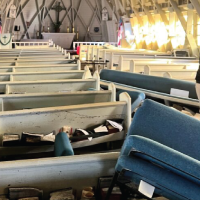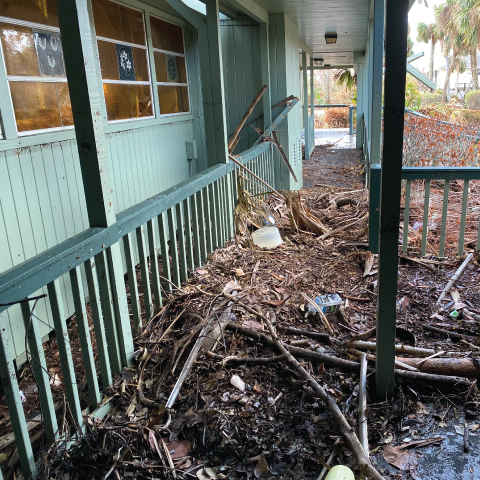Church Insurance: Anticipating and Improvising
2022 Year-End Issue
Two events in September—a devastating hurricane and the sudden arrival of some 50 refugees—are vivid illustrations of how Church Insurance Companies (CIC) helps set our clients’ minds at ease when their worlds are upended.
Going the Extra Mile and a Half
Before Hurricane Ian touched down on Florida and the Carolinas, CIC was already poised to dispatch our network of claims professionals and contractors.
We received about 30 claims for damaged Episcopal buildings by the time the storm subsided. Due in large part to our pre-storm communications and proactive follow-up, we inspected some 90% of those properties within one week, with remediation work underway.
However, despite our best efforts to be proactive, Kevin Smith, CIC’s Director of Property Claims who is based in Orlando, Florida, realized early on that a few clients in the storm’s path hadn’t yet contacted us. He decided to drive the several hours down to Southwest Florida to assess the situation.
“We opened new claims and notified the diocese,” Kevin said. “It definitely sped things up to start the process before our clients were even able to report the damage.”
Several clients on Florida’s barrier islands had no access to their buildings because of washed out causeways and bridges, including St. Michael and All Angels Episcopal Church on Sanibel Island. Its rector, the Rev. Bill Van Oss, arranged a boat and invited Kevin to join him, along with a claims adjuster and a remediation contractor.
As there were no docks, they clambered ashore after the 30-minute boat ride and walked a mile and a half to the church. Four hours later, they had completed a preliminary estimate and the contractor was preparing to start working.
“I’m grateful that Church Insurance was ready when we needed them. Their response was outstanding and it’s very reassuring to know they are helping us get back on our feet,” Father Van Oss said.
 “We've seen the uptick in recent years of the number and severity of storms, wildfires out west, the winter freeze across south Texas and other states—it’s challenging. But we're committed to working side-by-side with the Church from a risk management standpoint, to make sure Episcopal institutions are as well-prepared as they can be for these events.”
“We've seen the uptick in recent years of the number and severity of storms, wildfires out west, the winter freeze across south Texas and other states—it’s challenging. But we're committed to working side-by-side with the Church from a risk management standpoint, to make sure Episcopal institutions are as well-prepared as they can be for these events.”
-- Christopher Rourke, Senior Vice President and General Manager, Church Insurance Companies
Surprise Visitors
When the Rev. Chip Seadale, Rector at St. Andrew’s Episcopal Church in Martha’s Vineyard, received a call that nearly 50 refugees had arrived on the island unannounced, with no place to stay, and in need of food, clothing, and shelter, his first thought was, “That’s a lot of people.”
The church’s winter homeless shelter typically handled 15 to 20 individuals, so this was a stretch. “It was late in the afternoon. These asylum seekers, most of whom had come all the way from Venezuela, had nowhere to go. I knew we had to act quickly,” Father Chip said.
One worry that crossed his mind was insurance coverage. Then he recalled an earlier conversation with CIC about setting up the church’s winter homeless shelter. They had discussed risk management, sanctuary church insurance coverage, and being up to code with local authorities when churches choose to help those seeking refuge. “Church Insurance had said that ‘this is what churches do,’ and that we should feel comfortable creating the shelter,” he explained.
With a little bit of creativity, St. Andrew’s was able to accommodate all 48 guests, and an outpouring of community support helped provide everything needed to feed and house the group in comfort.
The visitors moved to a better-resourced location after two days, but Father Chip said the ability to mobilize quickly and help such a large group is a testament to the good will of the community and a reflection of the peace of mind that CIC provides when it comes to the unexpected.
Comments? Questions? Concerns? CPG is listening. Please reach out to us at corpcomm@cpg.org
